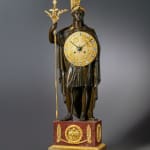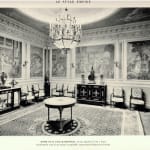
A virtually identical clock, entirely in gilt bronze with gilt bronze-mounted porphyry plinth (today in Stockholm Castle), is illustrated in Hans Ottomeyer and Peter Pröschel, “Vergoldete Bronzen”, 1986, p. 397, pl. 5.18.12.

A nearly identical clock in the Spanish Royal collection is illustrated in J. Ramon Colon De Carvajal, “Catalogo De Relojes Del Patrimonio Nacional”, 1987, p. 185, no. 165.

Hotel de M. Paul Marmottan, Avenue Raphaël No. 20, à Paris.
See figure of Pallas Athena on the commode.
Gérard-Jean Galle (attributed to)
Further images
Literature
A virtually identical clock, entirely in gilt bronze with gilt bronze-mounted porphyry plinth (today in Stockholm Castle), is illustrated in Hans Ottomeyer and Peter Pröschel, “Vergoldete Bronzen”, 1986, p. 397, pl. 5.18.12.
A nearly identical clock in the Spanish Royal collection is illustrated in J. Ramon Colon De Carvajal, “Catalogo De Relojes Del Patrimonio Nacional”, 1987, p. 185, no. 165.
A very similar clock, entirely of gilt bronze with gilt bronze mounts to the plinth (today in the Ministry of Foreign Affairs in Paris), is illustrated in Tardy, “Les Plus Belles Pendules Françaises”, 1994, p. 278.
A similar clock is illustrated in Elke Niehüser, “Die Französische Bronzeuhr”, 1997, p. 229, pl. 650.




